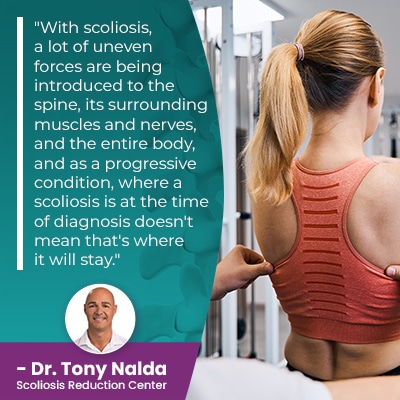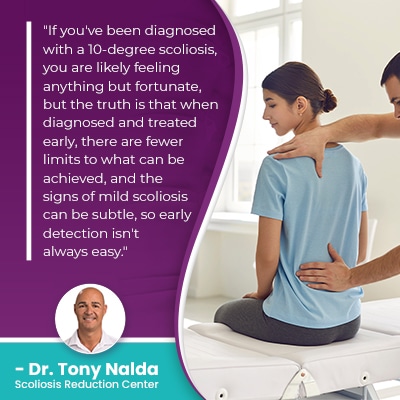10 Degree Scoliosis: Should You Wait For Treatment?

It's never too late to start scoliosis treatment, and the reality is that many cases of scoliosis don't require surgery. Early detection and intervention is important because as a progressive condition, scoliosis is incurable, but it can be highly treatable.
Regardless of severity or type, the best time to start scoliosis treatment is always now. As a progressive condition, a 10-degree scoliosis is virtually guaranteed to get worse, and as progression makes scoliosis more complex to treat, being proactive can be highly beneficial.
Let's start our exploration of why scoliosis treatment should be started early by first explaining how the condition is diagnosed.
Table of Contents
Have You Been Diagnosed with Scoliosis?
If you've been diagnosed with scoliosis, you've developed an unnatural sideways spinal curve that also rotates, and to be considered a true scoliosis, the curve has to be of a minimum size: Cobb angle measurement of at least 10 degrees.
There are different size ranges to people's spinal curves, and as long as they fall within a healthy range, a person's spine can remain healthy and strong, but if a person has an excessive and/or unnatural spinal curve, problems occur.
 With scoliosis, a lot of uneven forces are being introduced to the spine, its surrounding muscles and nerves, and the entire body, and as a progressive condition, where a scoliosis is at the time of diagnosis doesn't mean that's where it will stay.
With scoliosis, a lot of uneven forces are being introduced to the spine, its surrounding muscles and nerves, and the entire body, and as a progressive condition, where a scoliosis is at the time of diagnosis doesn't mean that's where it will stay.
So if you've been diagnosed with scoliosis, you need to understand the importance of starting treatment as soon as possible.
A patient's Cobb angle classifies conditions in terms of severity, and Cobb angle is determined during X-ray by drawing lines from the tops and bottoms of the curve's most-tilted vertebrae, and the resulting angle is expressed in degrees:
- Mild scoliosis: Cobb angle measurement between 10 and 25 degrees
- Moderate scoliosis: Cobb angle measurement of between 25 and 40 degrees
- Severe scoliosis: Cobb angle measurement of 40+ degrees
- Very-severe scoliosis: Cobb angle measurement of 80+ degrees
The specific parameter of 10 degrees as the diagnostic cutting point was decided somewhat arbitrarily by a Dr. William Kane in the seventies who wrote an article calling for a need to standardize the management and diagnosis of scoliosis.
So if a person is diagnosed with scoliosis at 10 degrees, what should they do?
Treating Mild Scoliosis
Now, how a diagnosis of mild scoliosis is responded to will vary greatly between the two main scoliosis treatment approaches: traditional and conservative.
With a diagnosis of a 10-degree scoliosis, those on the path of traditional treatment are told that as it's so mild, to watch and wait for signs of progression is enough of a response; this is because traditional treatment doesn't have an approach for treating scoliosis while mild.
Traditional scoliosis treatment offers a surgical response. The only form of treatment applied prior to a surgical recommendation is traditional bracing, commonly started when scoliosis becomes moderate, and as traditional bracing doesn't acknowledge the condition's true 3-dimensional nature, it's limited in its potential efficacy.
When/if a patient progresses into the severe classification at 40+ degrees, they cross the surgical threshold and are commonly funnelled towards spinal fusion surgery.
Spinal fusion surgery has the goal of stopping progression and works towards achieving this by fusing the curve's most-tilted vertebrae into one solid bone and attaching rods to the spine with pedicle screws to hold it in place.
Spinal fusion is a costly and invasive procedure that can cost the spine in terms of its overall health, strength, and function.
For those who choose to forgo surgical treatment and want to try a less-invasive non-surgical treatment option first, the success of conservative chiropractic-centered treatment proves that many cases of scoliosis don't need surgery.
Don't Wait for Treatment Because...
 The bottom line, when it comes to scoliosis treatment, is that it only gets more complex to treat the more it progresses, so don't wait to start treatment.
The bottom line, when it comes to scoliosis treatment, is that it only gets more complex to treat the more it progresses, so don't wait to start treatment.
If you've been diagnosed with a 10-degree scoliosis, you are likely feeling anything but fortunate, but the truth is that when diagnosed and treated early, there are fewer limits to what can be achieved, and the signs of mild scoliosis can be subtle, so early detection isn't always easy.
If a 10-degree curve is left untreated, it can easily become moderate scoliosis, severe scoliosis, or very-severe scoliosis over time, and in young patients, progression can be quick because growth is what triggers progression.
So what exactly does progression mean?
If scoliosis is progressing, the size of the unnatural spinal curve is increasing, and as that happens, the spine gets increasingly rigid, making it less responsive to chiropractic care, and making it difficult for some patients to perform certain therapeutic exercises as part of treatment.
As scoliosis is getting worse, the condition's uneven forces are also increasing, as are their effects; the main effect of scoliosis in young patients is postural deviation, and for adults, it's pain.
Scoliosis doesn't become a compressive condition until skeletal maturity has been reached, and once that happens, the spine and its surrounding muscles and nerves are vulnerable to compression, and this is the main cause of condition-related pain.
So in children who are still growing, the condition isn't commonly described as painful, making it hard to diagnose, and in mild cases, functional deficits are rare, again, making early detection a challenge.
So if early detection has been achieved, and at 10 degrees, it has been, what should be done?
Conservative Scoliosis Treatment
Conservative non-surgical scoliosis treatment is what I offer patients of the Scoliosis Reduction Center, and when I diagnose a 10-degree curve, I point out to patients that it is a positive to be diagnosed with scoliosis while it's still mild.
Mild scoliosis, if left untreated, over time, can become very-severe scoliosis, and this is what I want to avoid; I want to help patients avoid the hardships of progression, increasing condition severity, worsening symptoms, and the need for invasive surgical treatment in the future.
Here at the Center, I want to impact a patient's scoliosis on every level, which is why an integrative approach that combines multiple different types of treatment can be beneficial; the complex nature of scoliosis necessitates the full customization of treatment plans, and this is far easier to do when different treatment disciplines can be apportioned accordingly.
I apply condition-specific chiropractic care to work towards impacting scoliosis on a structural level in the form of a curvature reduction, and when scoliosis is mild at 10 degrees, this is when the spine is going to be at its most flexible and responsive because significant progression hasn't yet occurred.
So while traditional scoliosis treatment would say that scoliosis at 10 degrees is considered too mild to start treatment, as a progressive condition, we know it's virtually guaranteed to get worse at some point, so to me, waiting for a progressive condition to progress, while doing nothing, is wasting valuable treatment time.
If I start to see structural results as a scoliotic curvature of the spine is reduced, I can shift the focus to increasing core strength so the spine is optimally supported by its surrounding muscles, and in addition, physical therapy can address any related muscle imbalances, improve posture, and certain exercises are known to activate specific areas of the brain for improved brain-body communication.
Corrective bracing can also be helpful at augmenting corrective results by pushing the spine into a corrective position, and as bracing can be particularly effective on growing spines, the ScoliBrace is often a facet of treatment for adolescent idiopathic scoliosis patients.
Rehabilitation is key to further stabilizing and healing the spine, and this is achieved through a series of custom-prescribed exercises that help patient's establish a home-rehabilitation program.
Conclusion
I believe that treating scoliosis early in its progressive line is the best way to stabilize the spine and preserve as much of its natural strength and function as possible.
I do think that spinal fusion surgery can be appropriate in some cases, but not in all, and only when less-invasive more-natural forms of treatment have been attempted first.
I think that being proactive with treatment means starting as close to the time of diagnosis as possible, and if scoliosis is diagnosed at 10 degrees, then that's the best time to start treatment, quite simply, because there are fewer limits to what can be achieved.
Treating mild scoliosis is far simpler than treating severe and very-severe scoliosis, and scoliosis patients need to be aware that the longer their scoliosis is left untreated, the worse it's likely to get, and the harder it will be to correct without surgery.
Spinal fusion can indeed straighten an unnaturally-bent spine, but the fusing of vertebrae is contrary to the spine's movement-based design, and a loss in spinal flexibility and range of motion is the most common side effect, and it can significantly impact quality of life.
So if you, or someone you care about, has just been diagnosed with mild scoliosis at 10 degrees, this is precisely when treatment should be started, before progression has made the spine more rigid and less responsive to treatment; it's also far simpler to work towards proactively preventing progression, than it is to attempt to reverse its effects once established.
Dr. Tony Nalda
DOCTOR OF CHIROPRACTIC
After receiving an undergraduate degree in psychology and his Doctorate of Chiropractic from Life University, Dr. Nalda settled in Celebration, Florida and proceeded to build one of Central Florida’s most successful chiropractic clinics.
His experience with patients suffering from scoliosis, and the confusion and frustration they faced, led him to seek a specialty in scoliosis care. In 2006 he completed his Intensive Care Certification from CLEAR Institute, a leading scoliosis educational and certification center.
About Dr. Tony Nalda
 Ready to explore scoliosis treatment? Contact Us Now
Ready to explore scoliosis treatment? Contact Us Now





